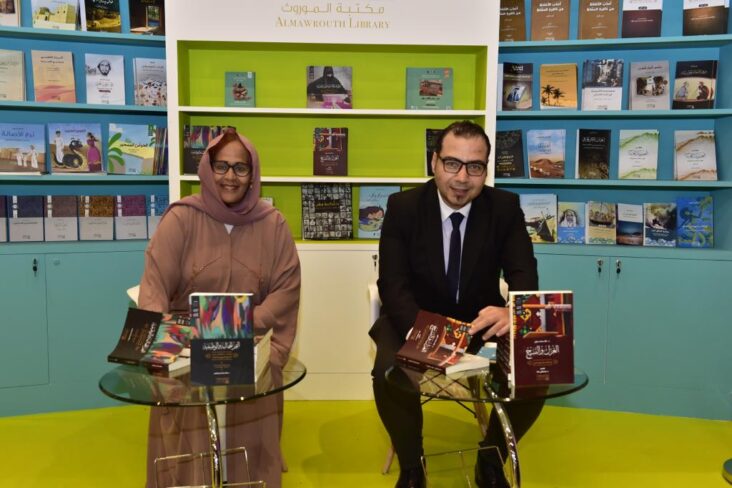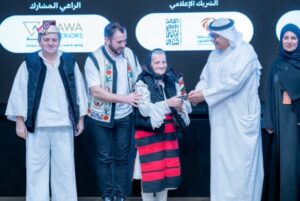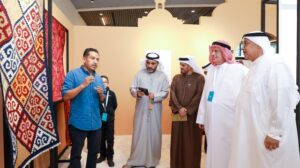The 13th Sharjah International Traditional Crafts Forum Brings Down The Curtain On Its Activities And Honours Participants And Supporters

Sharjah Institute for Heritage (SIH) brought down the curtain yesterday on the thirteenth edition of the Sharjah International Traditional Crafts Forum. Under the slogan “Carpets and Textiles”, the forum took place on January 18 and 19 at the Sharjah Research, Technology, and Innovation Park. The forum comprised extensive Arab and international participation and received a remarkable public turnout.
The closing ceremony was attended by His Excellency Dr Abdul Aziz Al-Musallam, Chairperson of Sharjah Institute for Heritage, Kholoud Al-Hajri, General Coordinator of the Forum and Director of the Emirati Handcraft Centre, and representatives of participating countries and institutions, partners, and supporters. It began with a traditional musical performance by the artist Mirza Al Mazmi.
Well-deserved honour
The ceremony included representatives of 17 Arab and international countries participating in the forum’s cultural programme and artistic workshops, entertainment and artistic showcase, and the accompanying exhibition. The University City of Sharjah was honoured for initiating the strategic sponsorship of the forum alongside the two media partners, Sharjah BroadcastingAuthority and the Sharjah Government Media Bureau.
Quality
His Excellency Dr Abdul Aziz Al-Musallam expressed his pride in the diversity of the participations and presentations submitted by Arab and international countries, which contributed to achieving the forum’s objectives in defining the textile and carpet industry and its role in economic and social development in the Arab world and beyond. He said it was important to highlight the industry, its pioneers, products, and how it developed throughout history, reviewing the best Arab and international experiences and practices to enhance the endeavours and initiatives of protecting, preserving and sustaining the intangible cultural heritage.
Fruitful partnership and appreciated support
For her part, Kholoud Al-Hajri, General Coordinator of the Forum, praised the efforts demonstrated by the sponsors, supporting institutions and individuals who contributed to the success of the forum and the professional team behind the implementation. She stressed that the Institute looks forward to the next session being more brilliant and dazzling with its objectives and activities. She revealed that the audience would have a date with a new traditional craft theme that links the past with the present, celebrates pioneers and roles, and is known for its cultural and historical impact on the development of society and the preservation of its values and identity.
Events continue
Training and entertainment workshops continued on the second day for the public and children focused on textiles, fashion and related manual skills. The International School of Story concluded its stories for children, with the participation of a group of students from the College of Fine Arts at the University of Sharjah. It also included performances by the Egyptian band and the Sharjah band.
The Origins Gallery.. A Journey into Consciousness
This year’s forum was distinguished by the presence and participation of the Mexican artist Porfirio Gutierrez, who showcased his excellent art exhibition “Origins… A Journey into Consciousness”.
Sharjah amazed me!
Gutierrez said: “Although I was born and raised in a society that crafts textiles, colors and dyes, Sharjah really amazed me with its architecture, interest in heritage, and institutions dedicated to preserving culture and protecting values.”
Art born fromnature
The Mexican artist relates his artistic experience to his upbringing in a world full of colours and an environment surrounded by mountains. He developed his knowledge of plants, their benefits and uses for healing and colouring until he learned the traditional natural Zapotec dye techniques. He then worked to revive, develop and preserve them, focusing on reinterpreting textiles and traditional materials to reflect his distinguished creative vision that has come to combine Mexican and American cultures.
Reinterpreting the language of textile
He talks about his artistic journey between several countries and cities: “Through my work in Ventura, California and Oaxaca, I have been keen to perpetuate the artistic experience using dyes from the colours of nature that I inherited from my ancestors. This traditional knowledge of the Zapotec has reflected in my textiles and my reinterpretation of the inherited textile language, relying on the re-imagining of symbols and shapes, and shifting my textile designs towards architectural fractal forms, and movement whose dimensions are inspired by the reality of cities and active urban environments.”
Mixing the traditional with the modern
He points out that he always relies on deep knowledge and the spiritual dimensions of his work. Still, he moves in his designs between traditional and modern and looks forward to achieving the dreams that his predecessors imagined.



